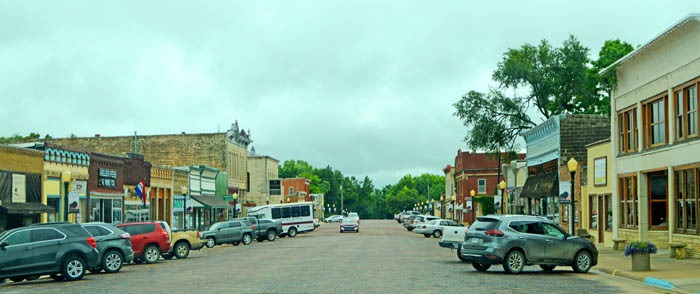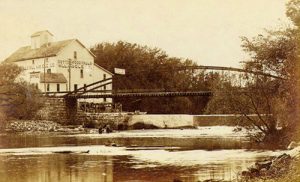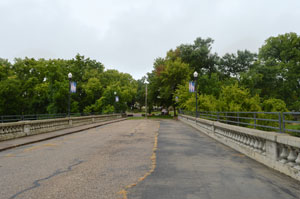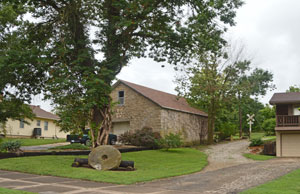Cottonwood Falls, Kansas, the county seat and largest town of Chase County, is located in the central part of the county on the Cottonwood River.
The first settlement in the Cottonwood Falls area began in 1854 when an Indian trader named Seth Hays founded a cattle ranch on the Cottonwood River close to the mouth of the Diamond Spring Creak. A post office was established in Cottonwood Falls on September 16, 1858.
When Chase County was organized in 1859, Cottonwood Falls was designated the temporary county seat. That year, a newspaper called the Kansas Press was started by Samuel N. Wood.
In 1860, a dam was constructed on the Cottonwood Falls River that consisted of cottonwood logs. This dam provided water power for a saw and grist mill. The same year, the townsite was laid out.
In 1862, an election was held for the permanent county seat of Chase County, and Cottonwood Falls received the majority of votes.
In 1870, the Congregationalists built a frame church for about $1,800. The same year, the Methodist Episcopal Church was also erected at about $2,500. In 1871, William A. Morgan established the Chase County Leader newspaper.
The same year, Chase County voters approved a bond issue to build a courthouse and jail. The architect and superintendent was John Q, Haskellya noted Lawrence, Kansas architect who also designed the State Capitol. The building was built from native limestone quarried and hand-cut in the Flint Hills. The limestone blocks were brought to the Courthouse by horse-drawn wagons; some stones weighed nearly seven tons.
At the head of Broadway, the 113-foot tall French Renaissance-style building was completed in October 1873 at $42,600. A housewarming and ball were held on October 17. The building has been in continuous use as the seat of county government since that time, and much of the building is virtually unchanged. It is the oldest Kansas Courthouse still in use. It is listed on the National Historic Register today.
In 1872, the town was incorporated as a third-class city, with W.S. Smith elected as the first mayor. The Atchison, Topeka & Santa Fe Railroad reached the Cottonwood Falls area that year. The first major bridge over the river was also built that year — a 150-foot-long iron truss bridge.
The Chase County National Bank was organized in June 1882 and began business on August 28, 1882. A new stone bank building was completed that year at $9,000 and occupied by the bank on January 1, 1883.
At that time, Cottonwood Falls had two hotels, two bakeries, two billiard rooms, two confectioneries, two meat markets, two livery stables, two coal yards, two blacksmiths shops, two millinery establishments, two furniture houses, two music and sewing machine stores, two hardware stores, two drug stores, two newspapers, a lumber yard, a brickyard, feed store, barbershop, a shoe shop, paint shop, harness shop, carpenter shop, and seven general stores. Professionals included two physicians, several attorneys, and an insurance agent. On the south side of the Cottonwood River was a watermill. The town’s population was about 520.
People traveling by train stopped at Strong City, just 1.5 miles to the north, where there was a conveyance in readiness to take them to the Union House on Broadway in Cottonwood Falls.
Through the late 19th and early 20th centuries, the area around the city was mainly divided into farms and cattle ranches.
In 1906, the dam was expanded and used to generate electricity. The present dam is constructed from cut limestone, which was later covered with concrete.
In 1910, the city was at the junction of two lines of the Atchison, Topeka & Santa Fe Railroad and was an important market for farm produce. Limestone was quarried nearby and shipped from this point, and brick for buildings and walks was manufactured in considerable quantities. There were two banks and two weekly newspapers — the Chase County Leader and the Currant and Reveille. The town was supplied with telegraph and express offices and had an international money order post office with one rural route. The population was 899.
In 1914, the Missouri Valley Bridge Company of Leavenworth, Kansas, constructed the present bridge over the Cottonwood River. It is one of only three remaining reinforced masonry, earth-filled arch bridges designed by Daniel B. Luten and listed on the National Register of Historic Places today.
The Chase County National Bank continued business at the exact location until it failed to open its doors on February 26, 1928. It then went into the hands of a receiver, and by June 1929, each depositor had been paid back in full. Some accounts trace the cause of the bank’s problems to poor and dishonest management in the early 1920s. In 1925, the bank president was charged with embezzling $39,018 from an estate for which he was executor. He was convicted in 1927, but the Supreme Court ordered a new trial. In January 1928, many depositors began withdrawing their savings, apparently thinking that a new trial might lead to more liabilities for the bank.
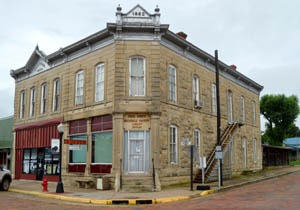
The Chase County Historical Society is located in the old Chase County National Bank by Kathy Alexander.
The building was later used by insurance agencies, real estate companies, the Farm Bureau office, and a ration stamp office during World War II. In 1976, the Chase County Historical Society purchased it for use as a museum, office, and historical library. The building is listed on the National Historic Register.
Cottonwood Falls’ population peaked in 1940 at 1,078 and gradually dropped in the following decades.
Today, this small town is called home to about 860 people. Its three-block-long Broadway Street is home to art galleries, boutiques, antique stores, museums, and restaurants. At the end of the block is the Chase County Courthouse, the oldest consecutively utilized courthouse west of the Mississippi River. The historic stone bridge over the Cottonwood River is at the other end of the street.
© Kathy Alexander/Legends of Kansas, updated September 2023.
Also See:
Sources:
Blackmar, Frank W.; Kansas: A Cyclopedia of State History, Vol I; Standard Publishing Company, Chicago, IL 1912.
Cutler, William G; History of Kansas; A. T. Andreas, Chicago, IL, 1883.
Cottonwood Falls, Kansas

